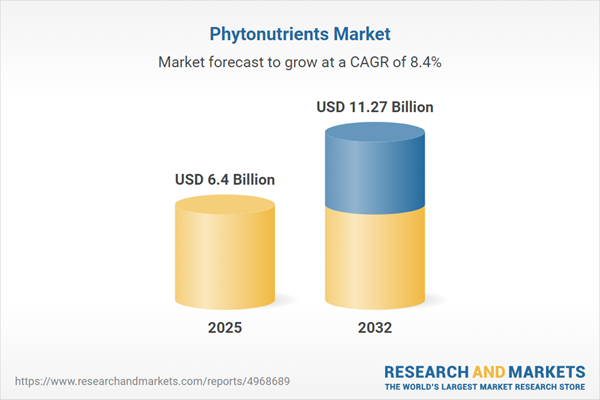Speak directly to the analyst to clarify any post sales queries you may have.
Senior decision-makers in the phytonutrients market confront persistent complexities as they steer their organizations through evolving regulations, rising sustainability demands, and the push toward digital transformation. Strategic adaptation and operational agility are essential for maintaining long-term relevance in this fast-changing sector.
Market Snapshot: Phytonutrients Market Size, Growth, and Outlook
The global phytonutrients market reached USD 5.90 billion in 2024 and is forecasted to attain USD 6.40 billion by 2025, driven by robust adoption of process optimizations and rising compliance benchmarks. This momentum is underpinned by ongoing clean-label initiatives and continued focus on operational excellence. With a compound annual growth rate (CAGR) of 8.41% projected through 2032, organizations need to adjust strategies to match technological advances and maintain competitive positioning across dynamic regulatory environments.
Scope & Segmentation: Executive-Focused Analysis of the Phytonutrients Market
This report delivers a clear, actionable framework for senior leaders to evaluate risks, uncover opportunities, and drive sustainable innovation in the phytonutrients market. The following key market segments reflect crucial intervention points for strategy and operational alignment:
- Phytonutrient Types: Carotenoids, flavonoids, glucosinolates, stilbenes, and tannins are central to innovation and help anticipate regulatory shifts in product development strategies.
- Source Categories: Beverages, fruits, grains, herbs, spices, and vegetables provide supply diversification, supporting procurement resilience and adaptability to changing resource availability or consumer expectations.
- Application Areas: Animal feed, cosmetics, dietary supplements, functional foods and beverages, and pharmaceuticals require targeted commercialization strategies and compliance pathways to address varied end-market needs.
- Form Factors: Capsules, tablets, powders, granules, blocks, emulsions, and tinctures ensure product versatility for regional market demands and regulatory conditions.
- End Users: Animal feed manufacturers, food and beverage producers, cosmetics companies, pharmaceuticals, and research institutions benefit from tailored compliance solutions and documentation.
- Regional Coverage: Americas, Europe, Middle East, Africa, and Asia-Pacific each present unique consumer trends, legal frameworks, and growth opportunities that shape corporate regional strategies.
- Leading Companies Profiled: Companies such as Archer-Daniels-Midland Company, Koninklijke DSM N.V., BASF SE, Cargill, DuPont, Kerry Group, Cyanotech, Ingredion, Chr. Hansen, and Synthite Industries define market standards and influence sector-wide benchmarks.
Key Takeaways for Senior Executives
- Prioritizing digital extraction and supply chain visibility strengthens organizational flexibility to respond to new compliance trends and evolving regulatory demands.
- Increased operational transparency and procurement diligence foster greater traceability and align with stakeholder clean-label expectations.
- Comprehensive risk management approaches and trusted supplier relationships boost enterprise resilience as legal conditions shift worldwide.
- Collaborative technology platforms and partnerships with adjacent industries serve as catalysts for accelerated product development and smoother entry into emerging markets.
- Deployment of advanced analytics enables improved traceability, supporting proactive responses to market evolution and regulator expectations as they arise.
Tariff Impact & Strategic Response
Recent changes in U.S. tariff policies bring additional volatility to the phytonutrients market. To safeguard continuity, senior leaders are emphasizing diversification of suppliers, transparent procurement workflows, and implementation of flexible contract management systems. These steps are vital to managing exposure and ensuring uninterrupted operations amid shifting global regulations.
Methodology & Data Sources
This report uses direct interviews with executives, patent reviews, regulatory filings, public databases, and current academic research to provide multilayered insights. The structured methodology ensures senior leaders secure data-backed intelligence for executive planning.
Why This Report Matters
- Delivers reliable benchmarks for informed portfolio alignment and strategic response amid regulatory change.
- Equips decision-makers with essential tools and processes to evaluate risk and address compliance across complex supply networks.
- Reveals actionable opportunities for technology integration and investment, supporting agile adaptation to market shifts.
Conclusion
Sustained growth in the phytonutrients market depends on agile business models, ongoing scientific advancement, and smart industry partnerships. Executive foresight and effective risk management will be central to navigating continual transformation and emerging sector challenges.
Additional Product Information:
- Purchase of this report includes 1 year online access with quarterly updates.
- This report can be updated on request. Please contact our Customer Experience team using the Ask a Question widget on our website.
Table of Contents
3. Executive Summary
4. Market Overview
7. Cumulative Impact of Artificial Intelligence 2025
Companies Mentioned
The companies profiled in this Phytonutrients market report include:- Archer-Daniels-Midland Company
- Koninklijke DSM N.V.
- BASF SE
- Cargill, Incorporated
- DuPont de Nemours, Inc.
- Kerry Group PLC
- Cyanotech Corporation
- Ingredion Incorporated
- Chr. Hansen Holding A/S
- Synthite Industries Ltd.
Table Information
| Report Attribute | Details |
|---|---|
| No. of Pages | 180 |
| Published | November 2025 |
| Forecast Period | 2025 - 2032 |
| Estimated Market Value ( USD | $ 6.4 Billion |
| Forecasted Market Value ( USD | $ 11.27 Billion |
| Compound Annual Growth Rate | 8.4% |
| Regions Covered | Global |
| No. of Companies Mentioned | 11 |









